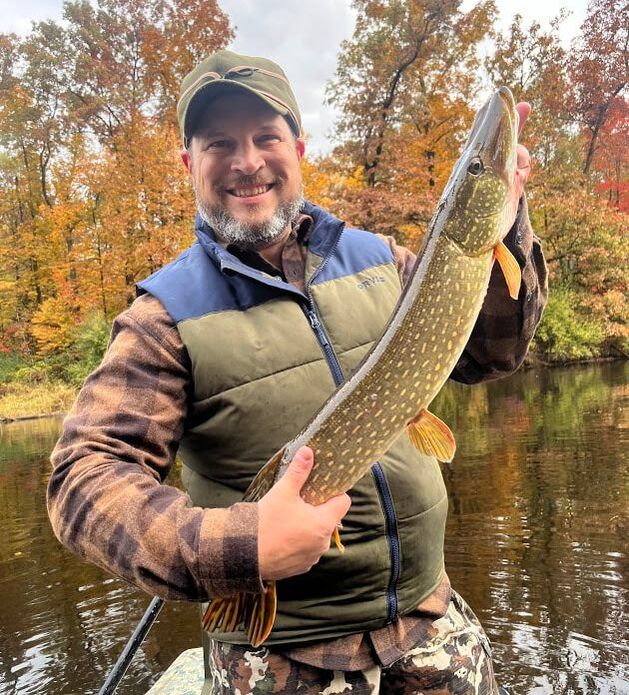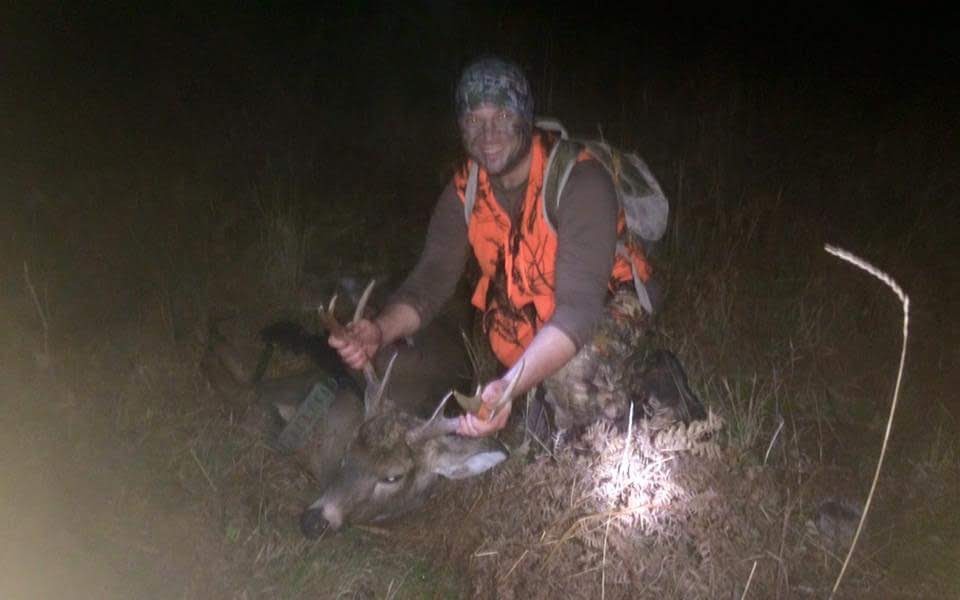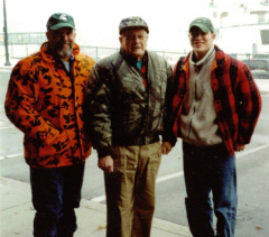|
By Drew YoungeDyke (Originally published in the November 2020 issue of Woods-N-Water News)
Many Michiganders, especially Yoopers, have heard of “sisu.” Sisu is a Finnish word with no direct translation into other languages which is roughly like combining grit, resilience, fortitude, and stubborn determination in the face of hardship over the long term. Though I grew up in the northern Lower Peninsula, I learned the term from the Finnish side of my family at our cottage in the western Upper Peninsula. I’ve often thought about what that term means to me and have often found it tested in the outdoors. The Finns had to have sisu to survive the harsh, cold climate of their country. Northern Michigan and the Upper Peninsula mirror that climate, which is part of what drew so many Finns to the Upper Peninsula, northern Wisconsin, and Minnesota to work in lumber camps and mines in the late nineteenth and early twentieth century, as it did for my family. The northern Michigan outdoors can test sisu in large and small ways. In 2014, when I was running the On the Ground (OTG) wildlife habitat program for Michigan United Conservation Clubs, we had a musky spawning structure project planned for March 1 on Chicagoan Lake in the Upper Peninsula. Seventeen volunteers signed up, but on the morning of the project the temperature was -16 F, not counting the wind chill on a frozen lake with no trees to block it. I was sure that most would be no-shows, and I would have understood. But then George Lindquist arrived, followed by all the others, and we spent hours on that ice assembling telephone poles like a tic-tac-toe board, securing steel mesh to the middle square, and filling them with fieldstones to sink them to the bottom of the lake when the ice melted. Every one of those volunteers showed sisu. I’ve also had it tested in physical endurance events. Yvon Chouinard, founder of Patagonia, has been quoted saying, “It’s not an adventure until something goes wrong,” and I kind of consider that to be when sisu kicks in, too. Cramping up in mile 12 of a 31-mile (50K) ultramarathon was when something went wrong; sisu was finishing the remaining 19 miles limping, cramping, slow, but not giving up and finishing anyway. In deer hunting, there are endless ways sisu gets tested in Michigan. Our weather conditions in late November – and our ethics as hunters - often require it. From where we set up our deer camp in the Pigeon River Country, I often still hunt routes that take me in a two or three-mile circular route through hilly wooded terrain, and at many points along it I can be up to a mile or more from camp. In 2015, I was fortunate to shoot a 3 ½ -year-old eight-point buck shortly before the close of shooting light. I was up on a ridge I’d still hunted to where I’d sat against a tree watching a trail. The buck was cruising the valley below and I shot him at a distance of about 70 yards. He ran up the opposite hill, back down, and collapsed less than 50 yards from where I shot him. I waited about 20 minutes, and it was dark by the time I found him. I was looking at close to a mile-long drag of a heavy-bodied deer in the dark after I field-dressed him. I could have marked my spot, gone back to camp, and returned in the morning with help. With coyotes around, though, I didn’t want to leave him so I grabbed an antler and started dragging him uphill. Luckily a pair of flashlights belonging to my dad and cousin shone from the top of the hill before I got too far, so my cousin and I each grabbed an antler and dragged him up the hill. I thought we could cut across a valley as a shortcut, but as it turned out it took us out of the way and we had to drag it back up a hill to get back on course, across a stump-and-slash covered clear-cut plateau, and down through the woods to our camp. There’s nothing particularly unique about this deer drag, but we had to show some sisu to complete it. When something went wrong (we went the wrong way) we had to gut through it with stubborn determination despite adding an extra hill and probably an extra quarter-mile to our drag. In Michigan, I suspect sisu gets shown by hundreds of thousands of deer drags in cold weather across rough terrain every year. Similarly, I think it’s sisu to gut out the discomfort and stay on stand when the weather is cold, when the seat is uncomfortable, and when every urge is to head back to camp for a hot meal. And maybe the most important way it shows in Michigan’s deer season is when a hunter loses a blood trail but doesn’t give up. Losing the blood trail is just the part that goes wrong; sisu is persisting in spite of that and making the small and widening circles to cut for tracks, to search for broken branches, and to find the deer no matter how long it takes. Part of sisu is being prepared. For instance, you can’t drag a deer out if you don’t have the physical conditioning to do it without a heart attack. You can’t stay on the stand when you’re cold and uncomfortable if you don’t have the cold-weather clothing to prevent frostbite and hypothermia. And you might not find your deer after losing a blood trail if you didn’t bring extra batteries for your headlamp. I train with trail-running and CrossFit to be in condition to drag deer and I camp out in the snow in the winter to know my limits and how to keep warm in the cold. Don’t try to drag out a deer if you have a heart condition or are just not in condition to do so or risk frostbite or hypothermia because you didn’t layer up. Sisu isn’t being reckless in the short term; it’s being determined in the long-term. Sisu is a special quality but it doesn’t have to be unique. Any person can show it; Michigan’s hunters just get more opportunities than most. When something goes wrong or gets hard this deer season – you shoot a heavy deer in a valley a mile from camp, you get cold and uncomfortable on stand, you lose your blood trail, or the million other things that can go wrong in deer hunting – don’t give up. Just look at it as a chance to show your sisu. Make the drag, stay on stand, find your deer. That’s sisu. By Drew YoungeDyke This Michigan Outside column was originally published in the December 2019 issue of Woods'N'Water News. A frigid dawn crusted the snow with a crunchy top layer that made still hunting all but impossible on last year’s opening day. As it warmed up, though, it became soft and quiet and fresh snow fell overnight. Early the next morning before dawn I crawled out of the sleeping bag on my cot in our deer camp’s outfitter tent in the Pigeon River Country State Forest and dressed for the day with the excitement of a child on Christmas morning: we had tracking snow.
Fresh snowfall during deer season awakens the inner Natty Bumpo of Northwoods hunters. At least it does for me as a dedicated still hunter unless conditions are absolutely prohibitive. It’s a method passed down to me from my dad and my grandpa, as was the Winchester Model 70 I loaded with Federal premium copper ammunition at legal shooting light. I hiked uphill into the woods behind camp and cut for sign, hoping to find a buck track that would fit one of my .30-’06 rounds but willing to follow a smaller buck or a doe that may attract one. When still hunting, I usually follow deer trails. Deer take the path of least resistance, and often it is the path that will allow me to travel more quietly through thick cover. Unlike farmland, on northern Michigan public land forests deer trails go all over, not following any one definitive runway. This allows a still hunter to follow one doe trail to the next to piece together a route consistent with the terrain and wind, always alert for deer sign and presence, but it also makes it difficult to tell which trails are being predominately used. I’ve become adept at following fresh deer tracks without snow, but when fresh snow blankets the ground the picture becomes infinitely clearer. On these days, with soft footfalls and hopefully falling snow to mask my scent and movement somewhat, I’ll take a promising track and just follow it wherever it goes. On the second day of firearm season last year I found a very fresh medium size track that could be either a large doe or small buck. I decided to follow it, even though I didn’t have an antlerless tag, in case it was a small buck or a doe that would cross paths with a larger buck. The wind cut generally crossways from the direction of the tracks and I followed them all morning through upland cover, wetlands, hardwood hills, young red pine valleys, around in a circle where it checked it’s back trail, and up along a ridge where I shot an eight point a few years ago. It was as good of a workout as you’ll find in the deer woods other than the drag out. Still hunting is the most all-consuming method of deer hunting for me. Every sense is engaged. Every twist and turn of the track, every new viewscape, tingles the senses with anticipation. Your eyes search below every red pine branch; maybe the deer bedded down. Looking for a horizontal shape in every stand of hardwoods. A flicker of an ear through the falling snow. Stopping and kneeling frequently to scan every quadrant with binoculars, wondering what could be on the other side: a six point you would gladly take for the freezer? A doe that will intersect the path of an older eight point farther on? Along the way, you learn more about the deer. Tracking snow has always told stories of the deer woods for observant hunters. During one of the first deer seasons I hunted at our former deer camp on Beaver Island, it told a story that, as much as any other, helped me understand the workings of nature. I followed the fresh track of a small deer along a trail just after dawn. From one side, a coyote’s tracks dropped in behind it. Another’s joined from the other side. The deer’s walking gait disappeared and reappearing in a bounding leap and the coyotes’ spaced out, but it was too late. A spatter of blood on the trail and then all three veered sharply off into the thick swamp. It can tell our tales, too. A few years ago, before we moved our deer camp to the Pigeon River Country, I was camped out alone away from the road behind a couple-year-old clear cut. My dad planned to meet me at the camp for lunch one day and hunt with me in the afternoon, so at dawn I followed the fresh track of a buck away from camp into the woods. I veered away from it to avoid putting the wind at my back at times and rejoined it, guessing from the cover and direction where it might be headed. Toward mid-morning, I saw the blaze orange of another hunter in the woods and was going to veer away in another direction, but the other hunter saw me as well and waved. The hunter’s outline looked familiar and I recognized my dad, but how did he find me a half mile from camp after I’d swung wide away? He couldn’t have followed my tracks and caught up to me, even as slow as I was going. He told me he saw the direction I was headed, saw the track I was following, and saw where I veered away from it. And since he taught me how to track and still hunt, how to hunt the way I did, he thought about what he would do, given the sign and terrain, guessed where I would end up if I did the same thing, and meet me there. And that’s exactly what he did. I wondered what tales I would trail on this hunt. What would the tracks tell me? I found fairly fresh pellets, which confirm that I’m not too far behind the deer. I see where it stopped to pee, though, and the yellow snow is behind it, indicating it’s likely a doe. I pass no fresh rubs. Finally, I see what I’ve been following. A horizontal brown body amidst vertical hardwoods. I see the doe just before she sees me and bounds away; I took that one step too many and too fast that every still hunter realizes a moment too late. Without an antlerless tag, it would be a pass anyway. I tracked another deer the next day and watched the doe from 40 yards away wishing I had an antlerless tag. They were the only deer I saw last season. Tracking snow has yet to connect me with a deer for the freezer. I’ve killed a few deer still hunting with a bow and a rifle, though, following deer trails without snow. My best deer, the eight point I shot from the ridge a few years ago, was killed after still hunting and following a fresh deer trail in the afternoon until it crossed a saddle into a valley I’d scouted in the offseason. I sat against the base of a tree on the ridge overlooking the valley and passed up a fork and two does before shooting the buck cruising for does. Just as every bend of the trail excites this hunter with anticipation while tracking deer in the snow, so does the dawn of each new season. My rifle is sighted in with premium copper bullets, I’ve scouted our public land hunting grounds, and my freezer is stocked with pasties ready to fill the cooler at deer camp. And this year, I drew a public land antlerless tag for Otsego County. Now if only I can get some tracking snow to go with it… (UPDATE: I still-hunted upon a pair of does, drew my rifle on one offhand, and as I hesitated - and probably moved the rifle too much - trying to ensure it wasn't a button buck, it blew and ran before I took the shot.) By Drew YoungeDyke This Michigan Outside column was originally published in the November 2019 issue of Woods'n'Water News. The springer spaniel darted in front of us, flushing a ruffed grouse from the hunter walking trail but too far in front of us for a shot. It was our only flush of the day, but the heartbeat thump that echoed through the woods was exciting for two new ruffed grouse hunters in our party from out West. We had covered over five miles of tough hiking both on the trail and most often off of it in the dense young forest cover grouse prefer. Ruffed grouse hunting offers a perfect opportunity to log some cardiovascular exercise while enjoying Michigan’s outdoors.
I have only hunted ruffed grouse a handful of times, shooting none and missing one. Every hunt – tagging along with more experienced upland hunters – has covered between about three and five miles of hiking. Unlike still-hunting for white-tailed deer, upland hunting goes at a much faster pace, often trying to keep up with my friends’ bird dogs in a skirmish line, through whatever cover may arise. Ruffed grouse prefer young forests which have a much thicker undergrowth than older canopied forests which block the sunlight, especially young aspen forests. The Mosinee Grouse Enhanced Management System (GEMS) in Gogebic County, about five miles south of Wakefield, holds multiple blocks of mixed age-class aspen stands and maple and oak forests interspersed by upland openings and hunter walking trails. Nine friends joined me there in late September as part of a cast and blast weekend of ruffed grouse hunting and northern pike fishing with non-lead ammunition and fishing tackle, based out of my family’s cottage on nearby Chaney Lake. Our party split into two groups. Jordan Browne of Michigan Out-of-Doors TV was filming so we sent him with the more experienced ruffed grouse hunters consisting of Michigan United Conservation Clubs president George Lindquist, Wisconsin Wildlife Federation president Craig Challenor, Michigan Chapter of Backcountry Hunters and Anglers co-chair Ryan Cavanagh, and Huron Pines AmeriCorps coordinator Sarah Topp. I joined the other group of my National Wildlife Federation co-workers Aaron Kindle of Colorado and Marcia Brownlee of Montana, and Wisconsin Chapter of Backcountry Hunters and Anglers members Bill Koepke and Marissa English of Wisconsin and their springer spaniel, Jango. While my western colleagues have hunted dusky grouse and sage grouse, they were surprised by how much ground we covered looking for Northwoods ruffed grouse. A 154-pound person burns an average of 370 calories per hour, according to the Center for Disease Control. Hiking on uneven ground, though, burns 28% more energy than walking on even terrain. Most grouse hunting occurs on uneven ground, even if the elevation is relatively flat as you step over fallen logs, duck under branches, and walk through a mix of ground cover types. While calories burned are a function of the hunter’s weight and will be different for every hunter on every hunt, it’s safe to say that it will be significantly more than the calories burned while sitting on the couch watching football game on television. Neither of our parties got a shot on grouse that day; the other party had three flushes but no shots through the thick and colorful late September foliage. Ryan had picked up a roadkill grouse on the drive over, though, so we cooked that up as a lunch appetizer to go with pasties from Randall’s bakery. A 4-oz. serving of ruffed grouse contains 29g of protein and 1g of fat, according to the USDA, making it a healthy source of lean protein. And if you use steel shot or another non-lead alternative, you keep it clean of lead toxicity both for anyone eating it and any raptor scavenging it if you wound or fail to recover it. The Mosinee GEMS site we hunted is part of the Michigan DNR’s network of 19 sites across northern Michigan and the Upper Peninsula which are managed specifically for high quality ruffed grouse habitat that is publicly accessible and easily recognizable. It is actually Gogebic County forest, known as the Mosinee Grade Tract. I learned from my mom’s cousin that my great-grandpa used to hunt that tract. Ruffed grouse habitat requires active forest management to keep young forests in rotation: this means trees have to be cut. In the Pigeon River Country State Forest, where I’ve hunted grouse and where I do most of my deer hunting, the DNR is planning an ambitious conversion of 88-year-old red pine stand choked with invasive species understory into an upland habitat mecca. The 230-acre stand will be clear cut and the ground roller-chopped to allow early successional aspen to regenerate, interspersed with oak and hawthorn plantings to provide wildlife food sources. This project will occur in a highly visible section of the forest, where many people may misunderstand the wildlife value of clear cuts like this. For a few years after treatment in 2021, it will look like a clear cut where pine trees now stand. But conservation is about the long term, and in a decade or so when my infant son is ready to start hunting with me – if he decides to – the area will be regenerating into aspen cover for ruffed grouse and I might finally be successful at hunting them! Ruffed grouse hunting has been growing on me as upland hunting friends have invited me along over the last few years. I enjoy the camaraderie, the terrain, the habitat, the dogs, the heartbeat thump of the grouse beating their wings, and the taste of the grouse my friends have shot. And I hardly even noticed that the whole time I was also burning calories and getting a great cardiovascular workout. Ruffed grouse hunting in Michigan is a perfect way to find fitness in the outdoors. |
AUTHOR
Drew YoungeDyke is an award-winning freelance outdoor writer and a Director of Conservation Partnerships for the National Wildlife Federation, a board member of the Outdoor Writers Association of America, and a member of the Association of Great Lakes Outdoor Writers and the Michigan Outdoor Writers Association.
All posts at Michigan Outside are independent and do not necessarily reflect the views of NWF, Surfrider, OWAA, AGLOW, MOWA, the or any other entity. ARCHIVES
June 2022
SUBJECTS
All
|




 RSS Feed
RSS Feed